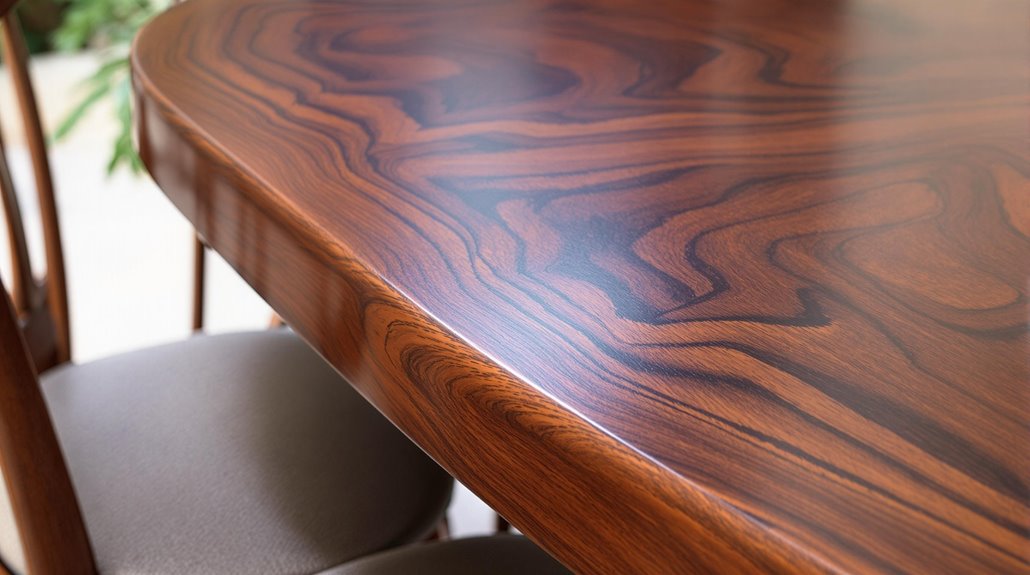The longest-lasting woods for furniture include teak, ipe, and mahogany, known for their remarkable durability and high resistance to decay. These hardwoods are particularly valued for their ability to withstand environmental stresses such as moisture and temperature fluctuations. Teak is often preferred for outdoor furniture due to its natural oils that repel water and insects. Ipe wood boasts an impressive lifespan of up to 50 years, while mahogany can endure for decades with proper care. To fully appreciate these woods and their characteristics, further insights into maintenance and other durable materials are essential.
Understanding Wood Durability
Understanding wood durability is vital for selecting furniture that withstands the test of time. Several factors influence durability, including the type of wood, with hardwoods generally outperforming softwoods in strength and resistance to damage. Specific hardwoods, such as oak, maple, and cherry, exhibit high durability, whereas softwoods like pine are more susceptible to dents and scratches. The grain patterns also play a significant role; straight grains are stronger, while knots and irregularities weaken the wood. Environmental conditions, including moisture content and temperature, further affect longevity, as high moisture can cause warping. Additionally, proper finishing and regular maintenance are important for protecting wood from wear, pests, and decay, thereby extending its lifespan and ensuring lasting quality in furniture.
Hardwoods for Lasting Furniture
Hardwoods are renowned for their exceptional durability, making them ideal for lasting furniture solutions. Among the most popular options are teak, ipe, and mahogany, each offering impressive longevity and resistance to environmental challenges, with proper maintenance enhancing their lifespan. Understanding the characteristics and upkeep requirements of these woods is essential for ensuring that furniture not only withstands the test of time but also maintains its aesthetic appeal.
Top Hardwoods Overview
When selecting materials for lasting furniture, the choice of wood is paramount, as certain hardwoods stand out for their exceptional durability and resilience. Teak is renowned for its longevity, particularly in outdoor settings, often lasting decades with proper care. White oak, known for its heft and resistance to warping, serves well in various applications, maintaining integrity over time. Maple, with its hardness, is favored for heavy-use furniture, such as dressers and kitchen cabinets. Black Locust offers remarkable structural strength and decay resistance, making it ideal for outdoor projects. Finally, Acacia, rich in oil content, provides durability against the elements and insects, ensuring longevity when adequately sealed. Each of these hardwoods exemplifies the characteristics essential for enduring furniture.
Durability and Maintenance Tips
Selecting the right hardwood for furniture not only guarantees longevity but also requires an awareness of maintenance practices to preserve its beauty and durability. Hardwoods like oak, maple, and cherry excel in durability due to their dense structure, while teak is ideal for outdoor settings due to its moisture and insect resistance. Regular dusting with a soft cloth prevents scratches, and immediate cleaning of spills minimizes staining risk. Using a mild soap solution and avoiding harsh chemicals is essential. Maintaining indoor humidity levels between 30 to 45 percent protects against warping, and using coasters prevents scratches. Additionally, applying wood conditioner and polish periodically nourishes and protects the wood, ensuring heirloom-quality furniture can last for generations.
Softwoods in Furniture Making
Softwoods play an essential role in furniture making due to their lightweight nature and ease of workability. Their lower density allows for easier handling, cutting, and shaping, which reduces labor costs and construction time. The fine, even texture combined with a lighter color palette enhances aesthetic versatility, making softwoods ideal for various finishes. Additionally, their simpler cell structure permits use with both basic hand tools and advanced machinery, resulting in precise cuts with minimal risk of damage. While generally less resistant to abrasion and impact than hardwoods, certain species like Douglas Fir offer notable strength and stability, making them suitable for structural applications. Overall, softwoods provide a cost-effective and practical choice for diverse furniture projects.
Outdoor Wood Species Overview
Understanding the characteristics of outdoor wood species is essential for selecting appropriate materials for exterior furniture and structures. Teak, renowned for its high density and natural resistance to decay, is an excellent choice for enduring outdoor applications. White Oak offers notable durability, repelling moisture and decay, while Cedar, with its aromatic properties, guarantees resistance to insects and rotting. Black Locust features tyloses that effectively block moisture penetration, enhancing its longevity. Ipe stands out for its extreme density and resistance to warping and decomposition. Other viable options include Cypress, appreciated for its varied heartwood colors, and Acacia, known for its sustainability and durability. Selecting the right wood species greatly impacts the longevity and aesthetic appeal of outdoor furniture.
Maintenance Tips for Longevity
Maintaining the longevity of wood furniture requires consistent care and attention to detail. Regular cleaning and dusting with a soft cloth can prevent scratches, while using a slightly damp cloth guarantees a thorough cleanse without damaging the wood grain. It is vital to clean spills immediately to avoid staining. Additionally, protecting furniture from environmental factors, such as direct sunlight and extreme temperatures, helps to prevent fading and cracking. Proper use, including employing coasters and avoiding heavy objects, further contributes to durability. Conditioning the wood with a suitable polish or wax nourishes and protects it from drying out. Regular inspections and prompt repairs of nicks or scratches are essential to maintain the integrity and appearance of the furniture over time.
Characteristics of Different Woods
The characteristics of different woods greatly influence their durability and suitability for various furniture applications. Hardwoods, such as Oak and Mahogany, are known for their density and resilience, making them ideal for long-lasting indoor furniture, while softwoods like Pine and Cedar offer a lighter, more affordable option, suitable for a range of styles. Additionally, when considering outdoor applications, woods like Teak and Ipe stand out for their exceptional rot resistance and stability, ensuring longevity in various environmental conditions.
Hardwood vs. Softwood Durability
Durability is a critical factor when choosing wood for furniture, as it directly influences both the longevity and maintenance requirements of the piece. Hardwoods, such as Oak, Maple, Cherry, and Mahogany, are generally more durable due to their slower growth and denser cell structure, offering superior resistance to scratches and dents. They perform well in various environments and exhibit better fire resistance. In contrast, softwoods, like Pine and Fir, tend to be less dense and may require treatment for enhanced durability. Although some softwoods, such as Western Red Cedar and Siberian Larch, demonstrate notable resilience, they often demand more maintenance. Consequently, selecting the appropriate wood type hinges on understanding these durability characteristics to meet specific usage needs.
Outdoor vs. Indoor Suitability
When selecting wood for furniture, understanding the distinct characteristics that make certain species suitable for outdoor or indoor environments is essential. Teak and Ipe are exceptional choices for outdoor use due to their high resistance to rot, decay, and insects, with lifespans reaching up to 50 and 40 years, respectively. In contrast, indoor options like White Oak and Mahogany excel in strength, durability, and aesthetic appeal, making them ideal for long-lasting furniture. While Redwood and Cypress also offer some outdoor suitability, they shine indoors where their natural beauty can be showcased. Ultimately, the choice between outdoor and indoor wood types hinges on factors like environmental exposure, maintenance requirements, and desired longevity, ensuring peak performance in their respective settings.
Heirloom-Quality Furniture Options
Heirloom-quality furniture options are characterized by their exceptional craftsmanship and the use of premium woods that can endure for generations. These pieces, often crafted from dense woods like oak, mahogany, cherry, teak, and white oak, exhibit remarkable durability and resistance to environmental factors. With proper maintenance, such as regular dusting and waxing, these woods can last for decades or even centuries. The core wood utilized in heirloom furniture enhances fire resistance and longevity, ensuring their value remains intact over time. Additionally, these furniture options are designed for generational use, capable of withstanding scratches and stains, making them suitable for both indoor and outdoor settings. Investing in heirloom-quality furniture not only offers timeless beauty but also secures a legacy for future generations.
Heavy-Use Furniture Recommendations
Selecting the right materials for heavy-use furniture is crucial to guarantee longevity and functionality. Hardwoods such as white oak, black walnut, and maple are highly recommended due to their durability and resistance to wear. White oak is particularly robust, while black walnut offers excellent dimensional stability and shock resistance. Teak, though costly, is rot-resistant and dense, making it ideal for outdoor applications. Black Locust presents a moderate price point with impressive strength and decay resistance. To promote the longevity of heavy-use furniture, regular maintenance, including waxing and appropriate cleaning, is essential. Additionally, choosing the right wood type should align with both the intended use and budget considerations, ensuring practical and aesthetic satisfaction in heavy-use environments.
Historical Wood Examples
Historical wood examples illustrate the remarkable durability and aesthetic appeal of various species utilized in furniture making across centuries. Teak wood, known for its natural oils that repel water and insects, can last a lifetime with proper care. Mahogany, favored by shipbuilders for its resistance to rot, demonstrates a longevity of up to 40 years outdoors. Similarly, Ipe wood boasts a lifespan of 50 years, showcasing its density and resistance to wear. Oak furniture, such as the desk presented to President Hayes, exemplifies durability, often surviving for centuries when maintained correctly. Additionally, redwood and cedar are renowned for their natural resistance to decay, making them suitable choices for outdoor applications, further highlighting the enduring legacy of these historical woods.
Sustainable Wood Choices
Sustainable wood choices are vital for creating long-lasting furniture while promoting environmental responsibility. Certified sustainable sourcing guarantees that wood is harvested in a way that maintains forest health and biodiversity, making it a pivotal aspect of responsible forestry practices. Additionally, the use of reclaimed wood not only reduces the demand for new timber but also offers unique character and history, effectively contributing to both aesthetic appeal and ecological conservation.
Certified Sustainable Sourcing
As the demand for environmentally responsible furniture grows, choosing wood that is certified sustainable has become crucial for both consumers and manufacturers alike. Certifications from organizations such as the Forest Stewardship Council (FSC) and Sustainable Forestry Initiative (SFI) indicate that wood is sourced from responsibly managed forests. FSC certification guarantees adherence to rigorous environmental and social standards, while SFI promotes sustainable forestry practices. To minimize environmental impact, it is essential to avoid wood from illegal harvesting or areas being converted to agricultural land. Sourcing locally not only reduces transportation emissions but also supports biodiversity by promoting selective logging and reforestation. Companies committed to sustainable sourcing often receive recognition, enhancing transparency in their supply chains and fostering responsible practices industry-wide.
Reclaimed Wood Benefits
Choosing reclaimed wood for furniture not only aligns with sustainable sourcing practices but also offers numerous environmental and practical advantages. By reducing the demand for new lumber, reclaimed wood helps prevent deforestation and ecosystem damage, thereby supporting biodiversity and air quality. This wood typically requires less energy to process, as it eliminates the need for harvesting new trees, thereby lowering fossil fuel reliance and minimizing the overall energy footprint. Additionally, reclaimed wood effectively reduces waste by repurposing materials that would otherwise fill landfills. Furthermore, its durability and stability are notable; older wood is often denser and more resistant to wear, making it ideal for high-traffic areas. Consequently, reclaimed wood serves both ecological and functional purposes in furniture design.

